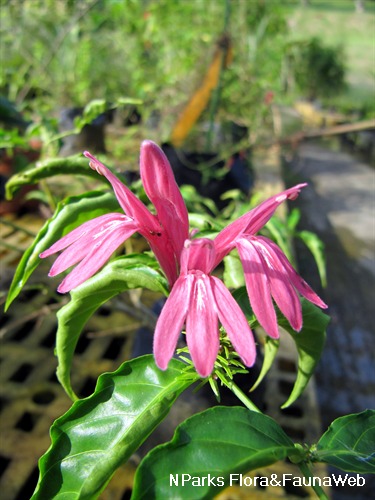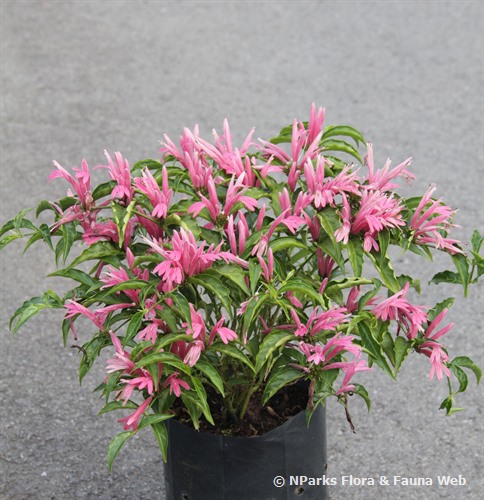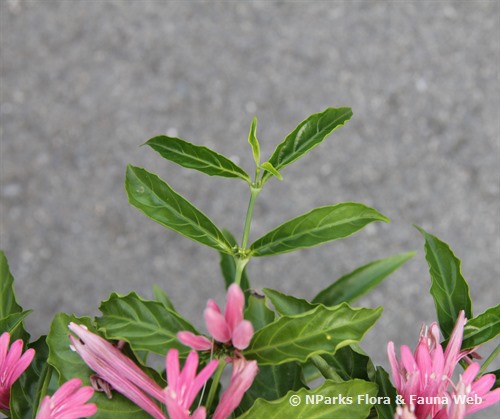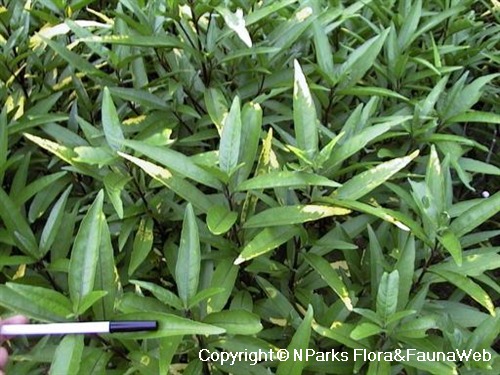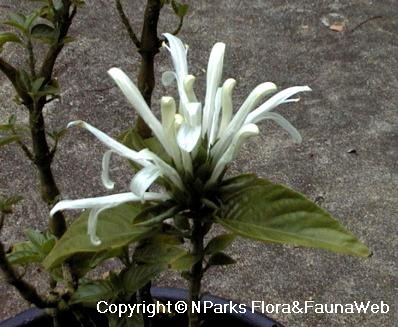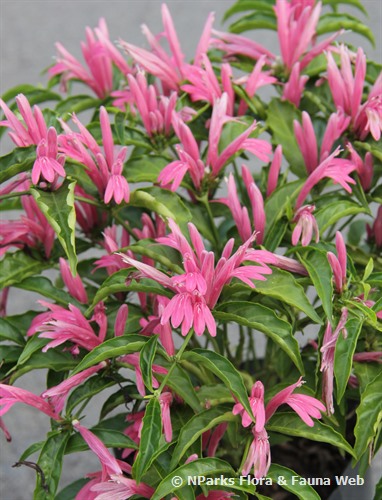
Back
Justicia candicans (Nees) L.D.Benson
| Family Name: | Acanthaceae |
| Synonyms: | Jacobinia candicans (Nees) Benth. & Hook. f. ex Hook. f. & B.D. Jacks., Jacobinia ovata A. Gray, Justicia mexicana Rose |
| Common Name: | Pink Justicia |
Name
Classifications and Characteristics
| Plant Division | Angiosperms (Flowering Seed Plants) (Dicotyledon) |
|---|---|
| Plant Growth Form | Climber, Shrub |
| Lifespan (in Singapore) | Perennial |
| Mode of Nutrition | Autotrophic |
| Plant Shape | Irregular |
Biogeography
| Native Distribution | Mexico |
|---|---|
| Native Habitat | Terrestrial |
| Preferred Climate Zone | Tropical |
| Local Conservation Status | Non-native |
Description and Ethnobotany
| Growth Form | It is a small shrub growing up to 90 cm tall with broad and spreading growth habit. |
|---|---|
| Foliage | Leaves are arranged oppositely along the stem, dark green with waxy margin, and have pinnate venation. Leaf blade is ovate with acuminate apex. |
| Stems | Stems are erect. |
| Flowers | Flowers borne on an inflorescence, located axillary along the stem, with pink tubular flowers and broad lower lip with white markings. |
| Habitat | In its natural habitat, it occurs along streams and canyon slopes, and between 500 and 1250 m in elevation. |
| Etymology | The genus Justicia is named in honour of James Justice, a Scottish legal clerk and horticulturist. The specific epithet candicans means white, or white woolly hair, which refers to the white markings on the flowers. |
Landscaping Features
| Landscaping | The bright pink flowers attract birds and butterflies and provide striking contrast against the dark green leaves, suitable for landscapes. |
|---|---|
| Desirable Plant Features | Ornamental Flowers |
| Landscape Uses | General, Suitable for Roadsides, Parks & Gardens, Small Gardens, Container Planting |
Fauna, Pollination and Dispersal
| Fauna Pollination Dispersal Associated Fauna | Bird-Attracting (Flowers), Butterfly-Attracting (Flower Nectar) |
|---|---|
| Pollination Method(s) | Biotic (Fauna) (Insects (Butterfly, Moth), Vertebrates (Bird)) |
Plant Care and Propagation
| Light Preference | Full Sun |
|---|---|
| Water Preference | Moderate Water |
| Plant Growth Rate | Moderate |
| Rootzone Tolerance | Moist Soils, Well-Drained Soils |
| Propagation Method | Stem Cutting |
Foliar
| Foliage Retention | Evergreen |
|---|---|
| Mature Foliage Colour(s) | Green |
| Mature Foliage Texture(s) | Smooth |
| Prominent Young Flush Colour(s) | Green |
| Young Flush Texture(s) | Smooth |
| Foliar Type | Simple / Unifoliate |
| Foliar Arrangement Along Stem | Opposite |
| Foliar Attachment to Stem | Petiolate |
| Foliar Shape(s) | Non-Palm Foliage (Ovate) |
| Foliar Venation | Pinnate / Net |
| Foliar Margin | Entire - Wavy / Undulate |
| Foliar Apex - Tip | Acuminate |
| Foliar Base | Acute |
Floral (Angiosperm)
| Flower & Plant Sexuality | Bisexual Flowers |
| Flower Colour(s) | Pink |
|---|---|
| Flower Texture(s) | Smooth |
| Flower Grouping | Cluster / Inflorescence |
| Flower Location | Axillary |
| Flower Symmetry | Bilateral |
| Individual Flower Shape | Tubular |
| Inflorescence Type | Umbel |
| Flowering Period | Free-Flowering |
Image Repository
Others
| Master ID | 30951 |
|---|---|
| Species ID | 5337 |
| Flora Disclaimer | The information in this website has been compiled from reliable sources, such as reference works on medicinal plants. It is not a substitute for medical advice or treatment and NParks does not purport to provide any medical advice. Readers should always consult his/her physician before using or consuming a plant for medicinal purposes. |

